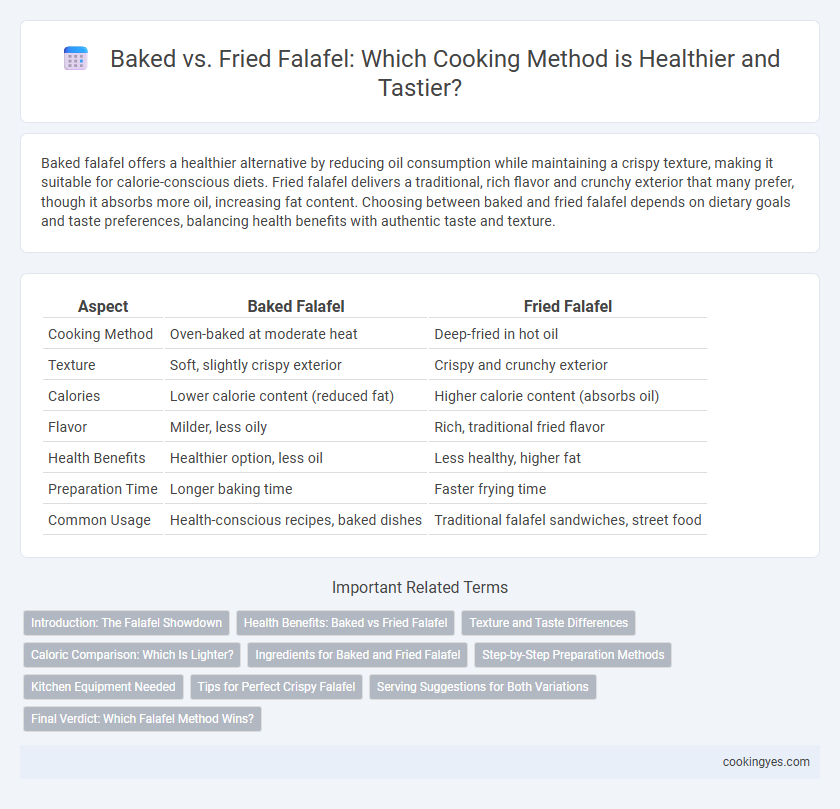Baked falafel offers a healthier alternative by reducing oil consumption while maintaining a crispy texture, making it suitable for calorie-conscious diets. Fried falafel delivers a traditional, rich flavor and crunchy exterior that many prefer, though it absorbs more oil, increasing fat content. Choosing between baked and fried falafel depends on dietary goals and taste preferences, balancing health benefits with authentic taste and texture.
Table of Comparison
| Aspect | Baked Falafel | Fried Falafel |
|---|---|---|
| Cooking Method | Oven-baked at moderate heat | Deep-fried in hot oil |
| Texture | Soft, slightly crispy exterior | Crispy and crunchy exterior |
| Calories | Lower calorie content (reduced fat) | Higher calorie content (absorbs oil) |
| Flavor | Milder, less oily | Rich, traditional fried flavor |
| Health Benefits | Healthier option, less oil | Less healthy, higher fat |
| Preparation Time | Longer baking time | Faster frying time |
| Common Usage | Health-conscious recipes, baked dishes | Traditional falafel sandwiches, street food |
Introduction: The Falafel Showdown
Baked falafel offers a healthier alternative by reducing oil content while maintaining crispy texture through high-temperature baking techniques. Fried falafel, traditionally cooked in hot oil between 350degF and 375degF, delivers a distinctive crunch and rich flavor, attributed to Maillard reaction caramelization. Choosing between baked and fried methods impacts calorie count, texture, and taste, making this culinary decision central to authentic Mediterranean cuisine.
Health Benefits: Baked vs Fried Falafel
Baked falafel offers a healthier alternative to fried falafel by significantly reducing oil absorption and calorie content, making it ideal for weight management and heart health. Fried falafel, though crispy and flavorful due to deep frying in oil, typically contains higher levels of unhealthy fats and trans fats, which may increase cholesterol and cardiovascular risks. Choosing baked falafel enhances nutrient retention and reduces harmful compounds formed during frying, supporting better overall nutrition and lower inflammation.
Texture and Taste Differences
Baked falafel offers a drier texture with a slightly denser interior and a milder flavor, making it a healthier alternative with less oil absorption. Fried falafel delivers a crispy, golden exterior and a moist, fluffy center, enhancing the traditional savory and slightly nutty taste. Texture contrast in fried falafel is more pronounced, while baked falafel prioritizes a softer bite with reduced greasiness.
Caloric Comparison: Which Is Lighter?
Baked falafel contains significantly fewer calories compared to traditional fried falafel, with an approximate reduction of 30-40% in total caloric content due to the absence of oil absorption during cooking. A typical fried falafel ball averages around 60-80 calories, whereas a baked falafel ball usually ranges from 40-55 calories. Choosing baked falafel offers a lighter, lower-fat alternative while preserving essential nutrients like protein and fiber from chickpeas.
Ingredients for Baked and Fried Falafel
Baked falafel typically uses a mixture of chickpeas, herbs, spices, and a binding agent like flour or baking powder to maintain structure without excess oil absorption. Fried falafel relies on the same base ingredients but often includes additional moisture such as water or lemon juice to create a batter that crisps effectively in hot oil. The choice between flour types, fat content, and moisture levels in the ingredients directly influences texture and flavor in baked versus fried falafel.
Step-by-Step Preparation Methods
Baked falafel requires soaking chickpeas overnight, blending them with herbs, spices, and baking powder, then shaping into balls before placing them on a greased baking sheet and cooking at 375degF for 25-30 minutes, flipping halfway through for even browning. Fried falafel involves soaking chickpeas overnight, grinding them with garlic, parsley, cumin, and coriander, forming mixture into patties or balls, and frying in hot oil at 350degF for 3-5 minutes until golden and crispy. Both methods start with soaking chickpeas but differ significantly in cooking techniques and texture outcomes, with baking offering a healthier option and frying delivering traditional crispiness.
Kitchen Equipment Needed
Baked falafel requires an oven or air fryer, enabling a healthier preparation with less oil and reduced frying smoke. Fried falafel necessitates a deep fryer or a heavy-bottomed pan filled with oil, maintaining the traditional crispy texture but demanding proper ventilation and temperature control equipment. Both methods benefit from a food processor to uniformly blend chickpeas, herbs, and spices for optimal consistency.
Tips for Perfect Crispy Falafel
For perfectly crispy falafel, use dried chickpeas soaked overnight rather than canned to maintain a firm texture during cooking. When baking, spread the falafel balls on a greased baking sheet and brush them lightly with olive oil to achieve a golden, crispy exterior. For frying, ensure the oil temperature is between 350degF and 375degF to prevent soggy or greasy falafel while retaining a crunchy crust.
Serving Suggestions for Both Variations
Baked falafel offers a lighter alternative ideal for serving with fresh salads, tahini sauce, and whole grain pita bread, enhancing a health-conscious meal experience. Fried falafel presents a crispy, golden exterior perfect for pairing with traditional accompaniments like pickled vegetables, hummus, and spicy harissa for a rich, flavorful bite. Both variations complement Mediterranean mezze platters and can be garnished with fresh herbs like parsley and cilantro for added aroma and color.
Final Verdict: Which Falafel Method Wins?
Baked falafel offers a healthier alternative with lower fat content and a firmer texture, while fried falafel provides the traditional crispy exterior and rich flavor that many prefer. Nutritional analysis shows baked falafel reduces calorie intake by up to 30%, making it ideal for health-conscious consumers, whereas fried falafel excels in authenticity and taste. Choosing between baked or fried falafel ultimately depends on prioritizing health benefits versus classic flavor and texture preferences.
Baked vs Fried for Falafel preparation Infographic

 cookingyes.com
cookingyes.com